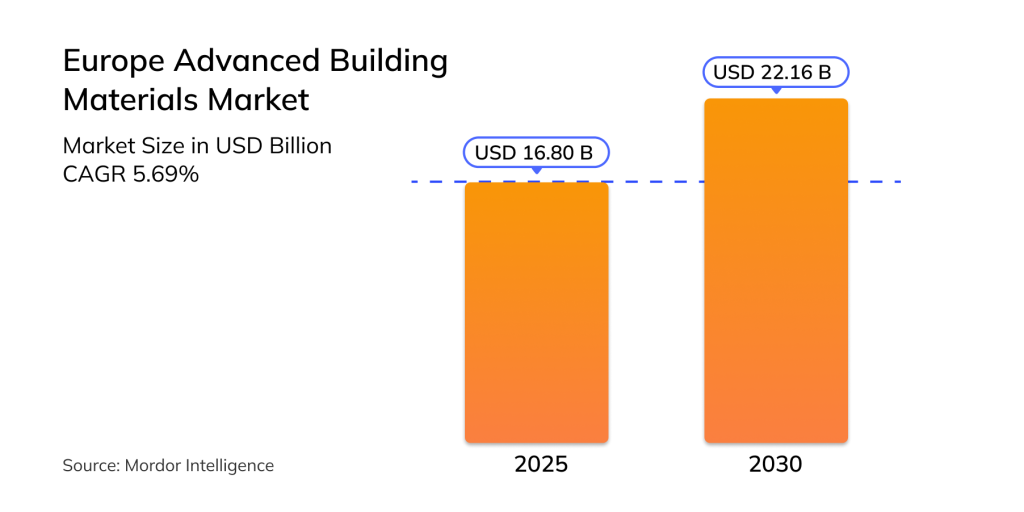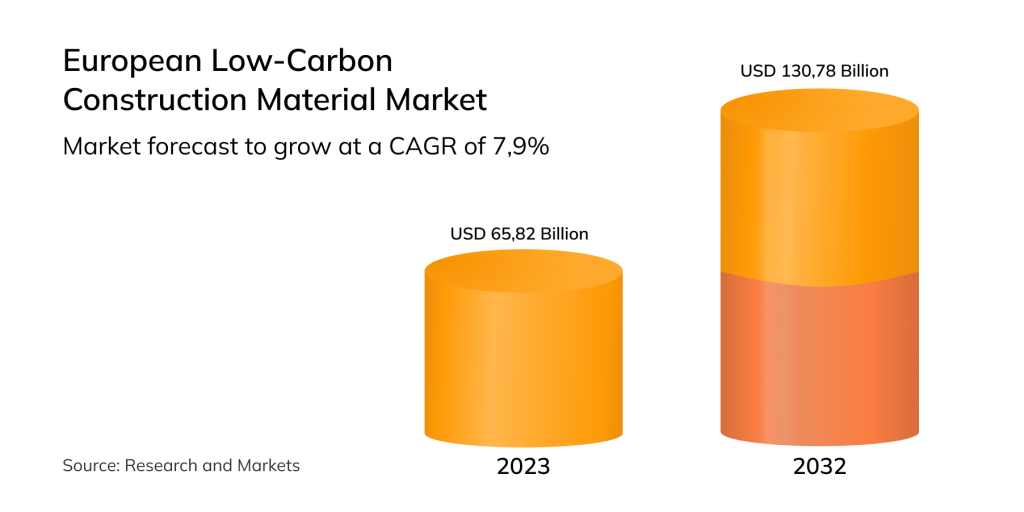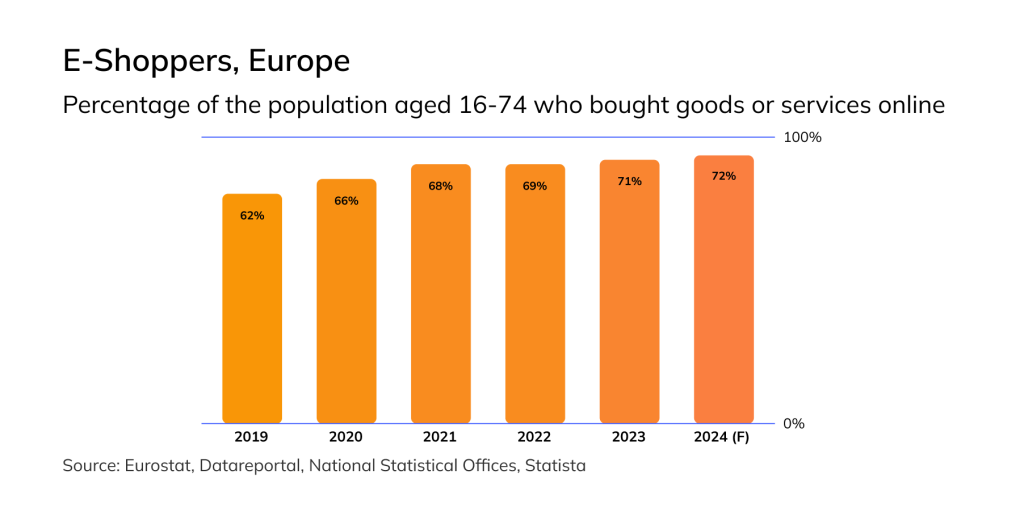European Advanced Construction Materials Market: Trends and Outlook for 2025–2030
August 1, 2025

The EU’s commitment to developing a low-carbon economy has led to substantial investments in energy-efficient items, fueling growth across the European Construction Market. According to Mordor Intelligence, the advanced construction materials market is expected to grow consistently at 5.69% per year, with its value forecast to hit USD 22.16 billion by 2030. In this article, we explore the main trends shaping the industry in the coming 5 years and highlight where new business opportunities may emerge.

Market Dynamics and Structure
In Europe, demand for construction materials is shaped not only by climate concerns but also by broader economic and demographic factors. According to Market Research Future, several key drivers defined the landscape in 2023.
- Residential construction dominated with a 42.2% share, fueled by population growth, ongoing urbanization, and social initiatives backed by governments and the public bodies.
- Commercial projects followed with 28.5%, fueled by business expansion and rising demand for offices, shopping centers, and hotels.
- Industrial construction — warehouses, factories, and production sites — accounted for 16.7%, explained by the fast-paced growth of e-commerce.
This trend remains stable. Market Data Forecast estimated the constructional market in 2024 at USD 160 billion. Germany, France, and the United Kingdom together contributed around 50% of that value, confirming their status as regional leaders.
Despite steady growth, the industry faces several structural issues:
- Skilled labor shortage. An aging workforce and outdated study programs have made it difficult to attract new talent. As a result, construction deadlines are increasingly delayed.
- Interrupted supply chains. The war in Ukraine has affected access to key goods, with a noticeable shortage among timber suppliers, delaying project timelines.
- Rising delivery costs. Disrupted logistics and resource shortages have driven up transportation expenses across the sector.
Still, the outlook remains positive — supported by the growing adoption of eco-conscious practices, which continue to draw investment and spark innovation across all stages of construction.
The EU’s Green Shift: What It Means for Future Construction Projects
European countries are pushing forward with policies aimed at cutting carbon emissions, improving air quality, and optimizing resource use. A major priority is the renovation of existing housing, as buildings are responsible for 36% of all greenhouse gas emissions in the EU.
Through the European Climate Pact, the EU has committed to doubling the rate of building renovations by 2030, targeting 35 million homes for upgrades to meet current environmental standards.
Why This Matters for the Materials Market
Using sustainable building materials will:
- Lower energy costs for heating and cooling spaces
- Cut down on carbon output
- Prevent mold growth and toxic emissions indoors
- Comply with official environmental standards, including certification requirements like LEED and BREEAM
As regulations evolve, demand for low-carbon construction products is set to rise. Key components expected to gain traction include:
- Smart products. These includeinsulation materials with shape memory, self-healing properties, or the ability to respond to changes in temperature or light.
- Nanomaterials. Enhanced with nanoparticles like titanium dioxide, silicon, or silver, these are used in cement, glass, and aerogels to enhance durability, lifespan, and performance
- Composite building materials. Consisting of multiple layers combining polymers and fibers, such as fiberglass, carbon fiber, or recyclable composite panels.

According to Research and Markets, the global arena for low-carbon construction materials will grow to $130.78 billion by 2032. Steady demand is expected from Developers, Contractors, and government-backed renovation initiatives.
How Suppliers Can Enter the European Market in 2025
With the construction sector adapting to stricter environmental standards, demand is growing for sustainable, certified supplies. Buyers now prioritize energy-efficient, locally produced goods and often require proof of compliance through certifications such as CE, EPD, FSC, BREEAM, and others.
This shift opens new opportunities for suppliers offering safe, environmentally responsible products. But quality alone is no longer enough.

The European E-commerce Report 2024 shows a consistent rise in buyers using online channels. A strong digital presence is now essential for reaching today’s construction materials market.
Now is the ideal time to establish your presence on e-commerce marketplaces. It’s a simple way to showcase your products, test the demand, and gain an advantage over competitors — all without significant costs or complicated technical requirements.
4 Reasons Why Suppliers Choose E-commerce Platforms
- Fast setup and user-friendliness. No need to build a website, hire IT staff, or manage complex systems. Simply register and start selling. The platform also helps manage contracts, monitor demand, and generate reports.
-
- Simple promotion. Many trading platforms include built-in advertising tools. Campaigns launch with just a few clicks and run automatically, saving time and marketing budget.
- Broad audience. Thousands of users visit these platforms daily, actively searching for construction materials. For example, [ServiCom] serves both B2C and B2B segments, helping you reach a wider customer base.
- Building trust. Open rating systems make it easier to gain credibility. Positive reviews improve your chances of long-term partnerships, and users tend to trust well-known marketplaces more than individual websites.
Using marketplaces is an effective way to test demand with minimal costs, benefiting from the platforms’ established reputation and active user base.
Tips for Entering the Market
Demand for eco-friendly construction materials is rising, making now the perfect time to establish your niche. To capitalize on this trend, take a strategic approach:
- Ensure your products meet quality and legal standards with official certifications. For example, Europe accepts only FSC-certified timber, and compliance is strictly monitored.
- Broaden your product range with in-demand items. If you offer insulation materials, add energy-efficient insulation solutions to your lineup.
- Tailor your brand messaging to align with European green standards — emphasize low carbon footprint, use of renewable resources, and health-safe materials.
- Start selling through Construction Materials Marketplaces, one of the easiest and least risky ways to enter the market.
- Collect customer feedback after every sale. A strong rating accelerates sales and builds brand trust.
By 2030, Europe aims to expand the sustainable building materials field significantly, driving the shift toward greener infrastructure. This creates new opportunities for suppliers prepared to meet current standards.
The most efficient way to access this potential is through online sales on marketplaces. If you want to quickly step into both B2B and B2C areas, plus access to marketing instruments and low administrative costs, consider listing your eco-friendly products on [ServiCom].










